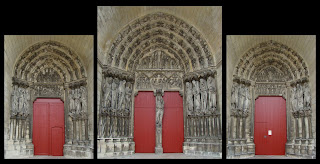How Great Thou Art Blog
Monday, May 23, 2011
So...
Sunday, May 15, 2011
Life After Death

It was built by Mughal emperor Shah Jahan in memory ofhis third wife, Mumtaz Mahal. The Taj Mahal is an icon in the modern world for love and sometimes even considered one of the wonders of the world today.
The Etruscans would place the corpses in sarcophagi. They were mostly meant to stay above ground, hence the elaborate construction of the reclining man and woman. Some, like the Etruscan one pictured (the Sarcophagus of the Spouses) were built freestanding, and placed in a tomb or crypt.
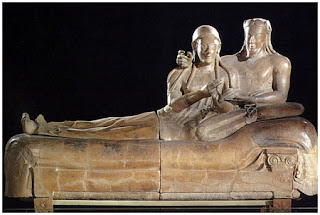 The two reclining are dining on a couch, which represents marital bliss. “Etruscans believed that death was the journey to the afterlife and had a fear that neglected dead may become malevolent; therefore, tombs were constructed with particular care, solidity, and lavishness” (Kozlowski). They would be elaborately constructed, so the dead would not haunt the living.
The two reclining are dining on a couch, which represents marital bliss. “Etruscans believed that death was the journey to the afterlife and had a fear that neglected dead may become malevolent; therefore, tombs were constructed with particular care, solidity, and lavishness” (Kozlowski). They would be elaborately constructed, so the dead would not haunt the living.
Friday, December 10, 2010
A Pop of Color
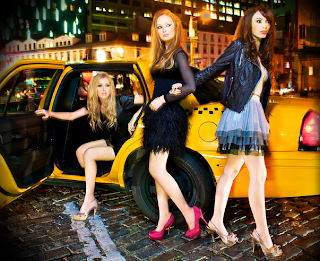 All three have on accessories like a pair of heels, or a jacket, or a bracelet. The
All three have on accessories like a pair of heels, or a jacket, or a bracelet. The
Friday, December 3, 2010
Which One?
The Betrayal of Christ
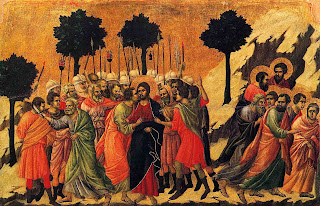
Duccio di Buoningsegna's The Betrayal of Christ depicts the capture of Jesus very clearly. There is no question as to what this particular painting is about. Judas is giving Jesus a kiss on the cheek to signify the guards which one he is and the disciples are running away. Christ is very easily spotted in the picture. Besides the kiss of Judas, Christ is in the center, he has a halo, and his robes are a blackish-blue color that completely contrasts the colors of His captors.
Friday, November 19, 2010
Needlepoint
The Fifer
For my entire life (or at least as far back as I can remember) I have looked at this little boy. He has been sitting on a chair in our living room for the past seventeen years. He never ages, he never moves, or plays that flute of his. He just sits on our sofa—a boy in needlepoint. This pillow has always fascinated me. When I was little I would look at it and wonder about it. At one point I even took it down to my room to sit with the rest of my dolls.
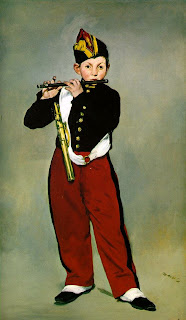
A couple months ago the Frist Center in Nashville announced that they were going to have an Impressionist exhibit of paintings from the Musee D’Orsay. The posters and signs had The Fifer on them but I was so surprised when I saw the Fifer’s rosy cheeks up on a billboard on the way downtown. I passed that billboard every day just waiting until the chance came that I could go see the exhibit.
I have always had a love for impressionist art—my favorites being Boudin’s seas and Degas’ ballerinas. I was able to see both of these at the Frist as well which was so exciting, but The Fifer was nothing that I could imagine. It was much larger in person. The Frist Center was something I was looking forward to for a while, but now that I’ve gone, I just want to go again……..
Friday, November 12, 2010
"The Girl Behind the Red Door"
Friday, November 5, 2010
The Blessed and the Not So Blessed

To his right the apostles stand facing away from Christ except for Peter who faces Christ and takes the righteous to heaven. Above the apostles, an enthroned Virgin Mary extends her hands in blessing while an angel trumpets to waken the dead. On the far left, the blessed ascend to heaven by holding on to the legs and wings of the angels. St. Peter oversees the operation with a key, and takes one righteous soul by the hand.
Below, more of the redeemed rise from their graves with the help of angels and rejoice. Towards the left, a person sits on his grave and unwraps his grave clothes, looking up in wonder. Among the saved can be spotted two bishops and two pilgrims. The pilgrims have symbols on their bags - a Greek cross for the pilgrimage to Jerusalem and a scallop shell representing Santiago de Compostela.
On Christ's right there is depicted the Weighing of Souls, presided over by Archangel Michael who leans on the scales to help them go in the right direction. Meanwhile, a devil attempts to sway the scales in his favor by hanging on them.
Along the bottom is an inscription warning against the horrors of Hell. On the far right, divided from the horrific scene by a vine, an angel trumpets to awaken the dead. Below this, more of the damned march to their doom. The most interesting are towards the right: a greedy man clutches his moneybags, and one sinner is pulled into Hell by two giant claws around his head. Two people sit on their tombs in their grave clothes. Compared with the joyful parallel on the left, they do not look to be in any hurry to cast them aside and stand up.
